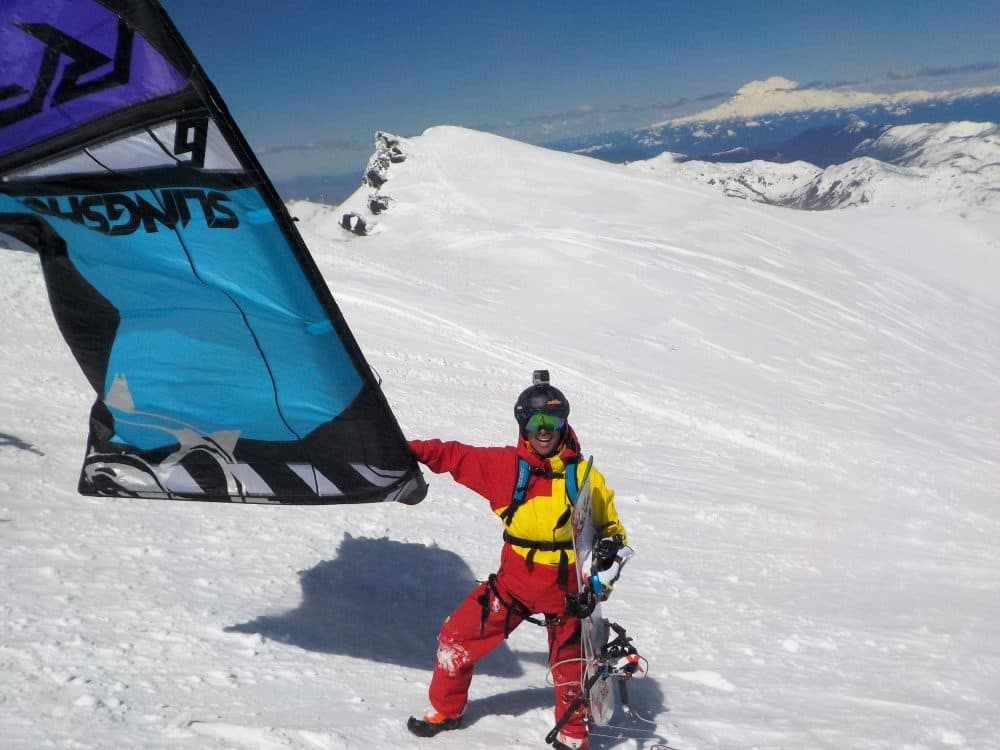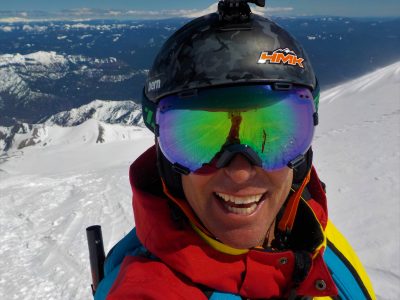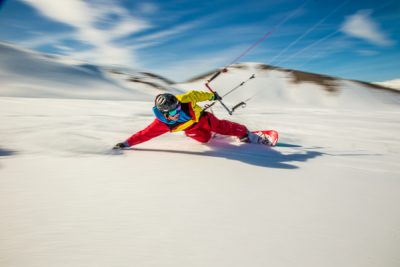Advertisement
Sailing 3,150 Feet On A Snowkite To The Summit Of Mount St. Helens
Resume
On May 18, 1980, Aaron Sales was a 6-year-old kid living in Kennewick, Washington. His family was driving home from church when a cloud of ash started to form over the town.
"The big cloud came closer and closer," Aaron says. "And then the ash started falling, and pretty soon we had and an inch of ash all over the ground. And we were outside playing in it with my brother and my neighbors."
Mount St. Helens had just erupted.
Fifty-seven people died and 200 homes were destroyed in the eruption. The event sparked Aaron’s lifelong fascination with the mountain.
"In my mind, it's a — it's a she," Aaron says. "It's a female. I refer to Mount St. Helen's as a her. And I feel like when I'm up there, it's like we talk. Like, she welcomes me. And I know it sounds a little weird, like, talking to a mountain. But that’s, kind of, that inner voice you have."
During the week, Aaron works for a company he co-founded, devising and guiding outdoor team-building adventures for employees of other companies. Aaron tells me he works in an office at least part of the week, but he always spends his Sundays on the mountain.
"Church, for me, is being up on the mountain," Aaron says. "That's where I am connected and most thankful."
'Superhuman Powers'
In his teens and early 20s, Aaron went to the mountains primarily to snowboard. Then, looking for a way to train during the summer, he took up kiteboarding: riding a board while holding onto a massive kite so the wind could pull him along the water.
It was 15 years ago when he became one of the first to put the two sports together and snowkite — that is, ride a snowboard while strapped to a massive kite that can pull him across fields of snow and up and down mountains. His kites have a bar that he uses like a tiller in a sailboat. He can turn the bar to steer left and right, to tack against the wind.
"Snowkiting gives you these superhuman powers," Aaron says. "If you go to the top of the hill, get a little bit of speed going down the mountain, and put the kite above you, it sends you directly into flight. And then all of a sudden, it's completely silent in the air. Sometimes, it feels like everything goes into slow motion. And, believe me, when I’m up snowkiting, I’m not thinking about work. Like, you have to be so on with every movement."
That’s because the kite’s lines can get tangled, making it impossible to steer. Or, the kite can lift the kiter off the mountain or pull him off the edge of a glacier or into a crevasse. Snowkiting requires big, open spaces above the tree line, so the kite doesn’t get tangled up in branches. Those open spaces tend to be the perfect places to set off an avalanche.

"I'm definitely a risk-taker," Aaron says. "I mean, if you're not taking risks in life, I think life is boring. And so I hope I live a long life, and I hope I am wild and crazy and still taking risks at 70 years old. I carry a picture of my daughters every time I go up on the mountains as a reminder that, 'Hey, it's just not worth it unless all the conditions align and it’s a perfect day.'"
Kite To The Top
About 10 years ago, Aaron was on Mount St. Helens, snowkiting back and forth without any particular aim, when he got a crazy idea. In all of his years of obsession with Mount St. Helens, he’d never been to the top. And he decided that someday, he’d snowkite there.
"If anybody should do it, it should be me," he says. "It needs to be me. It's my idea, and so I need to get to the top and do it. I want to push the limits of my physical and mental ability. Can your mind hold up for 35 minutes getting to the top? You know, at what point do you freak out and say, 'Gosh, this feels like avalanche conditions, I should turn around.' Or, like, 'This is really steep.'"
Over the past decade, Aaron’s gone back to the mountain at least a dozen times to try to summit. But, every time, something has gone wrong. Some days, the wind wasn’t strong enough to pull him up. Other days, the wind was too strong, and it seemed dangerous to attempt a summit. Once, his kite got caught on a rocky ledge and he had to pull his safety release so he wouldn’t follow his kite into a crevasse.
This April, Aaron decided to make one more attempt. The day seemed perfect. The weather forecast was favorable. The mountain pass between Hood River, where he lives, and Mount St. Helens had just been plowed.
So he and three of his buddies set off just after sunrise. They got to the mountain around 9 a.m.
"There's really this nervous energy, and it's like you want to pack everything right and you're all excited," Aaron says.
Aaron and his friends rode snowmobiles up to a snowfield above the tree line so they could unpack and unfurl their kites. That’s the first time they could actually see the summit.
"We realized, 'Is that a cloud on the summit? No, it's snow swirling,' and it looked like it was blowing at least 30 miles an hour on the top of the mountain," Aaron says.
Aaron wasn’t prepared for such strong winds, but he decided to go anyway.
'We're Going To Pull This Off'
Then, Aaron and his friends started unpacking their kites. Brad Gordon planned to ride up with Aaron that day, on skis instead of a snowboard. He’s a professional backcountry skier who’s worked on rescue patrols, and he’s been snowkiting for 15 years. But the binding on one of his skis was broken, and he wouldn’t be able to ride.
"It was just like, 'Well, whatever, first world problems, right?'" Gordon says. "It’s, like, you're in the mountains with your friends, you're gonna have some fun times. Yeah, your binding broke. Immediately I thought of, like, 'OK, well, we're going to pull this off, and we're going to pull it off safely. How can I help Aaron?'"
So, Brad made a new plan: He’d take another friend who came to take pictures on his snowmobile and drop him off halfway up the mountain. He didn’t dare go any further for fear of setting off an avalanche.
Meanwhile, Aaron discovered he had a gear problem too. He had meant to grab a big kite for the weak wind he had expected, but ...
"When I was packing it, I was all nervous," Aaron says.
And he’d messed up and grabbed a much smaller kite, one that he doubted he could get started in the gentle winds blowing for the first couple of miles. He decided to go for it anyway.
He started slowly, but then he hit the real wind.
"I had a lot of different natural features to navigate," Aaron says. "There's canyons. There's ridges. There's cliffs.
"Five hundred vertical feet from the summit, I realized, 'I think I'm going to make it. There's no reason I shouldn’t be able to make it.' And you just start getting these — this funny tingly feeling where you know that the finish line is in sight."
But, as Aaron approached the summit, he faced a new problem.
"Most mountains, when you reach the top, you're in a really large place to go and hang out," he says. "Mount St. Helens is really unique in that when you reach the crater rim, it’s a knife’s edge. If something were to go wrong and my kite dragged me out of control, it’s a 1,500-foot drop over the back side and into the crater. I mean, it's — it's certain death at that point."
Aaron had planned to quick-release his kite at the top of the mountain, letting the kite fly away.
"But I've actually, to be honest, never pulled my safety release in 40 knots of wind," Aaron says. "Those are usually conditions you don't kite in."
Crucial Catch
Aaron wasn’t sure what he was going to do. But, as he approached the rim, he saw someone standing in the distance. He was easy to spot — 6-foot-2, with his arms up. It was Brad. He had decided that the risk of Aaron flying off the mountain was greater than the risk of setting off an avalanche. And so he’d taken a snowmobile to the top to try and catch Aaron’s kite.
"It kind of felt like the mountain was a little bit upset or angry that we were up there, because the wind was just really ripping," Brad says.
It was so windy Brad worried he might not catch the kite.

"I felt like I was the little kid in the Little League World Series catching the pop fly, 'cause here comes the ball, and I knew I had one shot to catch this kite," Brad says. "I’ve caught hundreds and hundreds of kites, but this one, I knew it was mandatory and crucial to catch that kite right there."
Aaron steered the kite toward Brad, and Brad caught it. But he felt the danger wasn’t over yet.
"I've got this kite just raging in my hands," Brad says. "And the lines were kind of getting tangled, and it was really, really windy, and I got kind of emotional a little bit 'cause I knew Aaron would be super stoked. And I thought he’d belt out like a yell or something, but he was just giggling."
"So much was going through my mind of like, 1. I can't believe that just happened," Aaron says. "I just did it. To finally look inside the crater and see in the dome — and this is something I've been visualizing for years — and then to actually see it, I really felt like I was in a dream state. And I can't think of any other experiences in my life where I felt that alive."
"And I said, 'Aaron, we’ve got to get some photos, gotta get your photo, and let's get off this mountain, because it just didn't feel safe," Brad says. "You know, I didn't feel safe being up there holding this kite, you know. And I wanted to take the air out of it and pack it up."
Brad rode his snowmobile down and Aaron snowboarded. He says he came down in more ways than one.
"The day afterwards was almost like going through somewhat of a depression," Aaron says. "It's, like, 'Well, now what? Like, I'm sitting on a couch, and yesterday I was on top of a mountain?' It was really, like, 'OK, I just accomplished something I’ve been working on for 10 years.' I just felt like there was this big gap, there was this big hole. It's just really weird to go from the best day of your life to, like, 'Oh God, now what do I do with my life?'"
Aaron says he's figured it out. He next wants to snowkite up Mount Adams in Washington state and Mount Fuji in Japan.
This segment aired on August 12, 2017.